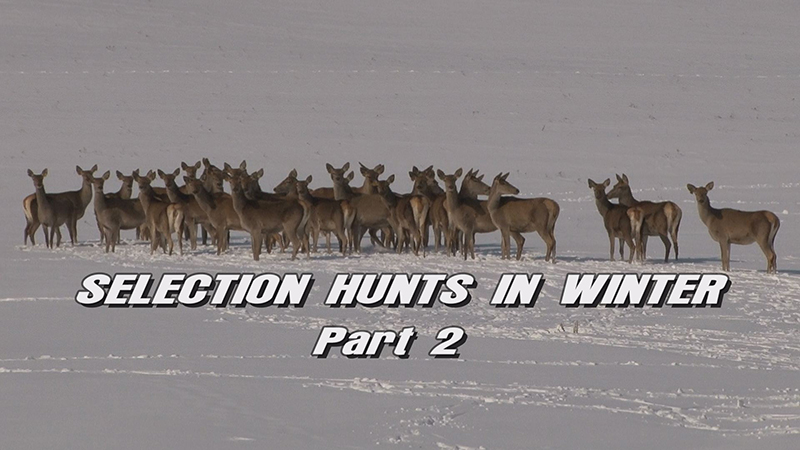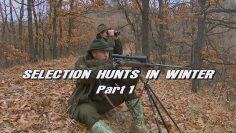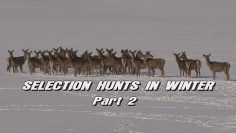Selection Hunts in Winter – Part 2
Directors
Biographical
“Hunters in Action” is founded and owned by the photographer and professional hunter Norbert Fenyvesi. Norbert is specialized in hosted hunting trips worldwide where he accompanies and guides hunters around the globe. With Norbert’s more than 200 travel days every year, you can expect continuously new exciting film content on this channel.
Selection Hunts in Winter (approx. 25 Min/Part)
In areas where deer hunting is a major part of the work of game management, usually in early October after the red deer rut has finished, hunts known as selection hunts take place.
One important function of selection hunts is to reduce the deer population to an optimal size by culling the hinds and calves. From a professional hunting standpoint, however, the main aim of a selection hunt is to ultimately improve the quality of stag antlers.
If there are too many females relative to the number of males living in a particular area, then the laws of nature will not prevail, according to which only the strongest males gain access to mating.
In the case of an excessively large population of females, stags with weaker or undesirable traits are easily able to find mates without competing for hinds. This, in turn, propagates their undesirable traits. In this unwanted situation, the new stags will undoubtedly inherit these poor genes.
If the number of individual females is kept to a low, optimized level through careful selection hunting, the result will be that during the rutting season, when the stags are struggling against rivals, only the best males will gain mating rights and in the long run, this leads to the improvement of the deer population.
The basic task of a proper selection hunt or culling, which targets the optimal age composition and correct male-to-female ratio, is to strive for improvement in the quality of antlers.
In a professional, selective culling, primary considerations are made for age, health status and physical condition of the animals. A hunter cannot go wrong if he chooses to shoot older animals, or those that are in a weaker condition than average, due to visible sickness or injury.
The female group typically consists of an experienced, healthy lead hind leading both calves and fawns. This position is not gained from winning a power struggle but rather the others instinctively follow this leader because the leader is older, has excellent health, can make quick decisions and has good reaction skills. The leading hind and her calf have strong traits, they should always be spared.
One can often see 3-member deer families, which are usually made up of a leading hind and one of her calves, as well as her young calf from the previous year.
These small trios should preferably be spared since if the leader of this group is self-confident enough to provide security for the little group, chances are that those traits of a “good” mother, will rub off on the young ones in her group. Lone individual animals however, that are seen at this time are always suspicious because in general they are somehow wounded or ill and have been abandoned from the group.
During the culling when choosing which hinds to shoot, first and foremost a hunter should take the health of the animal into consideration. Choosing to take an individual animal whose growth and development is stunted, or an animal which is sick, is a basic condition for the formation of a healthy population. Deer which have been hit by cars, injured by hunters or wild dogs, or those who have fallen victim to golden jackals must be released from further suffering. Weakened individuals have a very slim chance of surviving the hardships of the upcoming winter and many of them are likely will not live to see the spring. Those that do survive are likely to bear weak animals with less survival skills when they enter the world.
The intensity of the fallow rut in October should not be disturbed by taking a few does and fawns. During the reproduction period, the most important thing in terms of game management is that mature fallow buck hunts result in a successful take. Because of this, culling should therefore only begin after the mating season has ended. Like red deer, a sex ratio of 1:1 for fallow deer is also desired, and this ration is controlled by culling the appropriate number of does and fawns. On selection hunts, it is important to achieve the optimal age mix, which means that the greatest number of animals taken will be from the younger age group. Young bucks should only be taken if they are remarkably underdeveloped and/or have a mangy coat. The culling of deer is necessary to manage the population and for the most part, young does are the most recommended to be shoot. This is especially true because young does come into heat sooner than mature, older females and these young females bear fawns that are late in development and generally weaker than their peers in the group.
In the case of fallow deer, if you see the whole body of the animal, it is not difficult to distinguish the young females from the young bucks who have yet to grow antlers. The young bucks have a tuft of fur on their bellies and this clearly indicates the sex of the animal.
The wild boar is a very prolific and adaptive game species.
Due to extensive damage caused by the animal, domestic law permits the hunting of wild boar, without restrictions on age or gender, throughout the year. The very popular driven wild boar hunts play a significant role in reducing the boar population, but this type of hunting is not as useful for professional culling as hunts from blinds where it is much easier to judge and select the right animals.
For economic reasons, older animals, unless there are health reasons to deem otherwise, should preferably be spared. By and large, mostly juvenile individuals, piglets and gruntlings, should be taken.
The mouflon is a game species found in the higher regions of the Central Mountain Range in Hungary. This animal prefers to roam in large herds. Its home range is relatively small so it takes a significant toll on the vegetation in the area. Like red deer and fallow deer culling, for Mouflon a 1:1 sex ratio would be ideal.
In an optimal and sustainable mouflon ewe population, there are usually 15% lambs, 65% middle-aged ewes and 20% old ewes. This situation can be maintained for the most part by hunting young ewes.
The mouflon prefers rockier mountain terrain so they can be found everywhere in the Central Mountain Range of Hungary. The varied geography here results in grueling terrain, which makes a mouflon hunt challenging yet exciting even if you are hunting only for the female and young.
Roe deer is found in every part of Hungary. But most often they are found in forest patches, in reedy and grassy brush, and in agricultural areas.
For a roe deer selection hunt or culling, the aforementioned points considered for red and fallow deer are also relevant for roe deer. There is no significant difference in age composition and ratio of males to females from the other deer. During a selection hunt, hunters must be careful to take the allotted number of deer that is determined in the shooting plan with focus especially on the doe kids and old, mature does.
Of course, injured, sick, and shabby looking animals should be culled from the population.
In the case of roe deer, during a selection hunt, the main difficulty is that in the winter, the deer gather and are concentrated together in open areas around the remaining food sources, so, because of the lack of cover, it is very difficult to approach the animals.
Choosing the animal and taking the shot are often done at distances of sometimes hundreds of meters. This demands an excellent scope and choosing the right caliber as well as exceptional skills in rifle use.
What also complicates these selection hunts even further is the fact that at this time of year, the bucks no longer have antlers or you can't see the new antler stubs that have begun to form. The built and behavior can often even deceive expert eyes.
It is best to try and pay attention to the other signs on the animals that determine its sex. Bucks have a tuft of fur at the bottom of their abdomen while does have a tuft of fur at the base of the rump. Both of these can be seen from a long way away and can be used as the basis of determining the sex of the animal.
In the long run, hunting females and juveniles is more beneficial to the quality of the population than hunting males.
The females are not only actively involved in the breeding of the species, but a larger proportion of females takes part in breeding than males.
While as many as 80-90% of mature females take part in mating, (in the case of an optimal age composition of the population), only 25-30% of males are able to mate.
The young or weak males are defeated during the mating fights. When on selection hunts, older, healthier females should be spared because these are the ones that will bear strong calves. In particular the young hinds must be taken because compared to mature females, young hinds go into heat much later, and therefore give birth much later and the calves they bear are generally weaker animals. A young hind is markedly smaller and slimmer than a mature female.
Selection hunts of females and young results in fewer, but far sturdier, animals in the population. And in September during the rut, the struggles between stags are fiercer for the fewer hinds which, in the end, ensures that only the most outstanding individuals will be involved in the continuation of the population.










